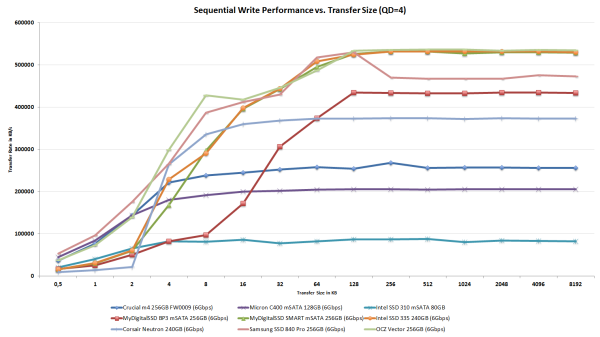MyDigitalSSD SMART & BP3 mSATA SSD Review
by Kristian Vättö on January 22, 2013 1:24 PM ESTPerformance vs. Transfer Size
ATTO is a handy tool for quickly measuring performance at various transfer sizes. While IOs in real world usually happen at specific sizes (mainly 4KB), it important to get a big picture of performance. The BP3 is able to keep up with read performance, but write speed is once again lacking. The SMART is unsurprisingly on par with Intel SSD 335, which is based on the same SF-2281 controller.
Click for full size












49 Comments
View All Comments
Flunk - Tuesday, January 22, 2013 - link
DIY upgrades are really what mSATA SSDs are for. They really don't make sense on the desktop. But I would argue that the performance desktop is just as much a niche market. As long as a market exists these products will too.As for me I have a ADATA SX300 mSATA SSD (256GB) along with a 750GB HD in an Alienware m14x R2. Great way to get more storage into a system that couldn't fit another 2.5" drive without losing the optical bay. mSATA SSDs are very convenient now.
Hopefully everyone will standardize on one of the new PCI-E based SSD specs, but that's all future technology for now.
Kraszmyl - Tuesday, January 22, 2013 - link
Considering almost all of dell and lenovos machines that came out recently have msata slots i wouldnt exactly call them rare and im sure the ultrabook people will move to them too.That being said i would like to see them on more itx and micro atx boards.
ssj3gohan - Tuesday, January 22, 2013 - link
Yeah, I'm super-happy with the mSATA slots on recent Intel mITX and mATX motherboards. It may seem like a small deal to some, but mSATA saves a lot of space and IMO more importantly: a mess of wires.I've been able to build very capable systems with no wires blocking airflow and getting in the way at all in arguably the smallest enclosure commercially available, the mini-box M350. All because of motherboards supporting 19V input and mSATA.
JarredWalton - Tuesday, January 22, 2013 - link
mSATA is already being phased out for NGFF/M.2, so I don't expect a lot of support for mSATA going forward. Apple, ASUS, and others already skipped mSATA to go their own routes, indicating the perceived issues from those manufacturers.M.2 will hopefully bring more standardization and acceptance, and it would be great if ASUS, Apple, etc. used M.2 instead of proprietary connectors -- there are quite a few people that are ticked that UX21A/UX31A had review samples with SF-2281 ADATA drives and then shipping consumer models typically (maybe even only?) used SanDisk U100. Because of the proprietary connector, there's basically no way to upgrade from the U100.
ssj3gohan - Wednesday, January 23, 2013 - link
I don't necessarily care whether it's NGFF or mSATA, as long as it's a cableless solution and there's sufficient availability of drives. Right now mSATA has good market penetration; I haven't had any problems sourcing tens of crucial m4 mSATA drives, even the most exotic 256GB variant. Same goes for myDigitalSSD's earlier offerings, which seemed to be in stock all the time (very short lead times).As soon as NGFF is used or can be used on the desktop I'm perfectly happy using those as the ubiquitous boot drive.
Voldenuit - Tuesday, January 22, 2013 - link
Exactly!mSATA SSDs are a good way to add performance and capacity to a (compatible) laptop. And doing it aftermarket keeps the OEMs from ripping off the customer with their exorbitant upgrade prices.
I added a 128 GB crucial m4 SSD to my wife's Thinkpad X230T laptop to complement the existing 500GB hdd. It was far cheaper than configuring it with a 2.5" SSD from lenovo (there was no option on their configurator to outlay the laptop with a mSATA SSD instead) and far more versatile, as the single-spindle X230T is now transformed into effectively a 2-spindle machine (still no DVD drive, but we have an ultrabase mobile dock for that).
I wouldn't buy a modern laptop that doesn't have an mSATA slot today.
cmikeh2 - Tuesday, January 22, 2013 - link
While traditional forms of computing may not necessitate the smaller form factor future products like Intel's Next Unit of Computing with its 4 x 4 inch mobo only supports mSATA. Work in this form factor will allow products like NUC to be worthwhile.digitalzombie - Tuesday, January 22, 2013 - link
"the potential to grap a large share"grap -> grab
Kristian Vättö - Tuesday, January 22, 2013 - link
Thanks for the heads up, fixed! :-)kesh - Tuesday, January 22, 2013 - link
Just a guess, but wouldn't there be a market for mSATA in embedded computing world?I have an ongoing project of turning a broken (slim) CD player to a digital audio player, which has been going slow over a last few years, and when I first saw mSATA, I immediately thought it as the perfect storage solution for my project.